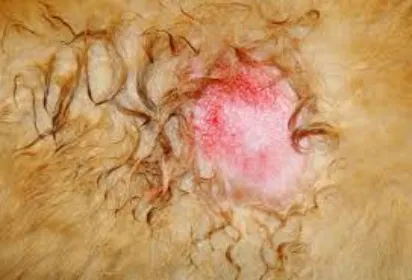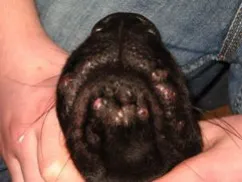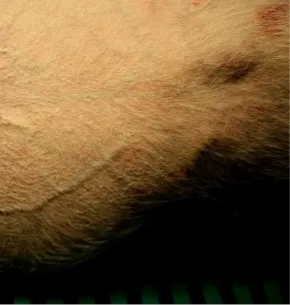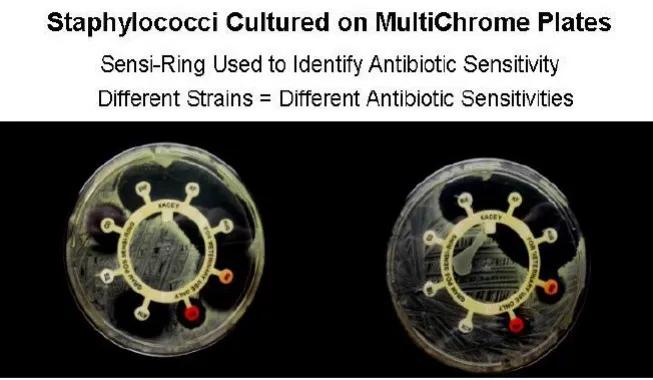Montgomery Pet Skin and Ear Clinic
Dr. Louis N. Gotthelf
(Member American Academy of Veterinary Dermatology)
Canine Pyoderma (Pus in the skin) or Bacterial Skin Infection
Bacterial folliculitis is the most common type of bacterial skin infection in the dog. The Staphylococcus pseudintermedius bacteria, which is a normal resident bacteria of canine skin, can cause infection of the skin in some dogs. Current theories indicate that most dogs who develop the
infection, particularly recurrent infections, have an underlying abnormality of their metabolic or immune systems. This form of pyoderma is a frequent complication of environmental allergies, food hypersensitivities, skin parasites (mites, fleas) and endocrine diseases, like hypothyroidism. An idiopathic primary bacterial folliculitis is also seen in short-haired dogs.
Pus Filling the Hair Follicle Spotty Infected Follicles Wide Ruptured Pustules
Located within the hair follicle, this bacterial infection causes
- Inflammation in and around the hair follicle
- Itching in some cases
- Hair loss in many cases
The clinical signs of bacterial folliculitis can be quite variable and may include
- Pustules
- Papules (pink or red swelling on skin), heat and crusts
- Erythema (redness)
- Alopecia (hair loss)
- Hyperpigmentation (darkening of the skin)
- Some dogs develop large circular area of hair loss with crusting or scaling around the border
- Superficial erosion and scaling
- Draining tracts
- Pain or discomfort

Acute moist pyoderma (Hot Spot)

Chin Acne is often a bacterial
infection
SKIN BACTERIAL CULTURING can be done in our office. Dogs that have had long standing pyodermas are the best candidates for antibiotic sensitivity testing. We can get culture and antibiotic sensitivity results in 24 hours in our own bacteriology mini lab. We also can test for MRSP, a methcillin resistant form of antibiotic resistant bacterial skin infections, similar to MRSA in people.
Using this technology, we can often find an antibiotic that will help the infection in cases of resistant bacterial skin infections that have been treated with multiple antibiotics. That gives the patient a fast start to therapy. Dr. Gotthelf has been instrumental in helping to develop these patented SensiRings.
- Surface pyodermas
- Skin fold pyodermas (face wrinkles, vulva fold)
- Hot spot (pyotraumatic pyoderma)
- Superficial pyodermas
- Bacterial folliculitis in short-haired breeds
- Impetigo and bacterial folliculitis (pustular, immune disorders, demodex mange)
- Mucocutaneous pyoderma (autoimmune disorders, metabolic disorders)
- Deep pyodermas
- This is a serious bacterial infection with inflammation of surrounding deep tissues.
- Furunculosis - rupture of infected hair follicles caused by deep fungal infections, eosinophilic autoimmune disorder with lesion on top of nose.
- Abscesses
- Chin acne
- Bacterial pododermatitis (fungal, autoimmune, foreign body, demodex mites, idiopathic)
- Lick granulomas and callus pyoderma
Diagnostic Tests:
- Skin scrapings for mites
- Skin cytology to look for bacteria
- Fungal culture
- Wood's lamp examination for ringworm
- Bacterial culture and susceptibility testing
- Thyroid hormone testing
Treatment:
A satisfactory resolution of pyoderma comprises both the cure of the cutaneous signs and the prevention of recurrences. As most pyodermas are secondary infections, the diagnosis and control of the underlying problem is mandatory for a good therapeutic success. If the underlying illness is not controlled, the pyoderma may recur after the antibiotics are interrupted. On the other hand, if the underlying cause is corrected, but the pyoderma is not treated, the bacterial infection may not heal on its own
While surface pyoderma may be treated with topical therapy alone, superficial and deep pyoderma require treatment with systemic antibiotics.
Topical therapy can involve the use of antibacterial shampoos (see below) and sprays. In some cases, we will use special types of antibacterial (not antibiotic) cremes and lotions.
Antibiotics:
This type of therapy can become quite confusing and if the antibiotic is not chosen correctly, resistance and deeper infection can result. Skin antibiotics are classified in tiers. The first tier antibiotics are those that typically kill Staphylococci readily in the skin. Examples of this type of antibiotic include Cephalexin, Cefpodoxime, Trimethoprim/Sulfas, Erythromycins, Clindamycin, and Amoxicillin/Clavulanate.
Second tier antibiotics can kill Staphylococci and some other types of bacterial infections of the skin, but they are reserved for documented (cultured) skin lesions when tier 1 antibiotics are not working. Examples of this type of antibiotic include Doxycycline, Chloramphenicol, Fluoroquinolones, and injectable Gentamycin and Amikacin
Typically, a minimum of three weeks of oral or injectable antibiotic therapy is required. If the proper antibiotic is chosen to kill the bacterial infection, the signs will subside within a week. However, if the antibiotic is stopped, these infections will flare up again and the results may be worse than first noticed.
Bacterial pyoderma requires a course of oral antibiotics for seven days past resolution of the clinical signs.
An antibiotic that is specific and effective at killing Staphylococcus pseudintermedius and penetrates skin is indicated.
Some Staphylococci have become resistant to many antibiotics. These are called Methcillin Resistant Staphylococcus Pseudintermedius (MSRP). At Animal Hospital of Montgomery, we can now do an in house bacterial culture for these resistant bacteria, which can also tell us which antibiotic might work best for a resistant infection.
Shampoos:
Shampooing is the most frequently used treatment and it should be allowed to soak for 10-15 minutes, and then thoroughly rinsed. Regular dog shampoos or flea and tick shampoos are good for cleansing the skin and haircoat, but they are not good for skin infections.
The shampoos used to treat a bacterial skin infection are specially made for dogs. They contain ingredients that remove much of the surface debris from the skin and they have antibacterial compounds that help to kill bacteria in the skin. We recommend 4% chlorhexidine, 2% benzoyl peroxide, or sodium hypochlorite (bleach) shampoos to treat bacterial skin infections.
Treatments should be repeated initially 2-3 times weekly. Antibacterial conditioning sprays can be used be sprayed on the skin between bathing days. Shampoo therapy is eventually tapered to once weekly or twice monthly when the disease improves. An excessively frequent use, particularly of strong agents, such as benzoyl peroxide, may lead to excessive coat dryness and skin irritation.


